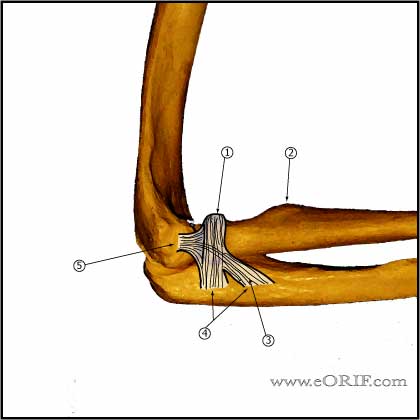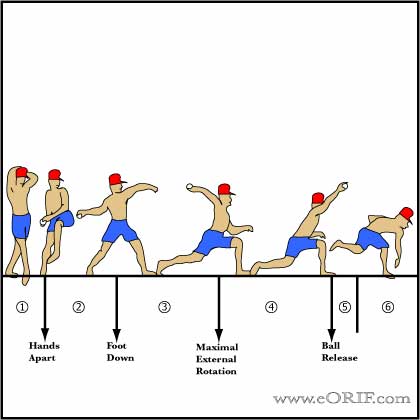|


|
synonyms: medial collateral ligament sprain, medial elbow instability, elbow UCL rupture, UCL instability, ulnar collateral ligament tear
Medial Elbow Instability ICD-10
A- initial encounter
D- subsequent encounter
S- sequela
Medial Elbow Instability ICD-9
- 841.1 (sprain and strain of elbow; ulnar collateral ligament)
Medial Elbow Instability Etiology / Epidemiology / Natural History
- Throwing exposes the medial elbow to high tension forces and the lateral elbow to high compression forces.
- Repetitive valgus stresses to the elbow occuring during the late cocking and acceleration phases of throwing can lead to MCL incompetence, ulnar neuritis and posteromedial olecranon impingement.
- Associated with Baseball, javelin, and raquet sports (tennis, )
Medial Elbow Instability Anatomy
- Valgus stability to the elbow is provided by: MCL, olecranon/trochlear articulation, flexor-pronator muscle mass (FCU is primary, FDS is secondary), radiocapitellar articulation,
- Elbow MCL consists of anterior bundle, posterior bundle and transverse segment
- Anterior bundle: origin=inferior aspect of the medial epicondyle. Insertion=sublime tubercle of ulna. Primary restraint to valgus stress at the elbow.
- Posterior bundle; Origin=medial epicondyle slightly posterior to its most inferior portion. Insertion=broadly onto the olecranon
- See also Elbow Anatomy.
Medial Elbow Instability Clinical Evaluation
- Pain localized to the medial elbow generally in the late-cocking or acceleration phases of throwing. May or may not have preceeding injury.
- Acute injury may be associated with a "pop" sensation.
- Medial elbow tenderness, loss of throwing velocity.
- Associated ulnar neuritis causing paresthesias in the posteromedial elbow to the ring and small fingers may be the first complaint.
- Elbow effusion: uncommon. Pts with large effusion will hold the elbow flexed 70° to 80°, which corresponds with the greatest capsular volume. (Timmerman LA,AJSM 1994;22: 26–32, 1994).
- Valgus Stress Test: valgus load applied to elbow with the elbow flexed 20° . Positive results = reproduction of medial elbow pain and valgus laxity greater on injured side as compared to contralateral side.
- Moving Valgus Stress Test: rapid extention from full flexion while maintaining a constant valgus stress. Positive result = reproduction of medial elbow pain.
- Milking maneuver: patient or examiner pulls on the patient's thumb creating a valgus stress, witht he patient's forearm suppinated and elbow flexed 90°. Medial elbow pain indicates medial elbow instability.
Medial Elbow Instability Xray / Diagnositc Tests
- A/P, Lateral and oblique elbow xrays. Generally normal. May show MCL calcification, medial humeral osteophytes, ulnar osteophytes, posterior olecranon spurring or loose bodies may be seen in chronic cases.
- Valgus stress xrays: >3mm medial opening on side-to-side comparisions is diagnositic of valgus instability
- MRI arthrogram: study of choice for elbow MCL injury. Evaluate for T sign of ulnar avulsion, humeral MCL avulsion or midsubstance tearing. Normal MCL appears as a thin band of low intensity along the medial elbow. Tearing is indicated by signal attenuation or absence. (Timmerman LA, AJSM 1994;22:26), (Munshi M, Radiology 2004;231:797), (Schwartz ML, Radiology 1995;197: 297).
82. Sisto DJ, Jobe FW, Moynes DR, et al: An el
- CT arthrography: sensitivity of 86%, specificity of 91%. (Timmerman LA, AJSM 1994;22:26),
Medial Elbow Instability Classification / Treatment
- Non-operative: Rest from throwing. Physical therapy with stretching, flexor-pronator strengthening and modalities. May start sport-specific activites at 3 months focused on adjusting patients throwing mechanics. 42% return to previous level of competition at an average 24.5 weeks after diagnosis (Rettig AC, AJSM 2001;29:15).
- Throwing athlete, failed non-op treatment: MCL Reconstruction.
- Non-throwing athlete, failed non-op treatment; women: MCL Reconstruction or capsular plication / MCL repair (Argo D, AJSM 2006;34:431).
Medial Elbow Instability Associated Injuries / Differential Diagnosis
Medial Elbow Instability Complications
- Posteromedial olecranon impingement
- Ulnohumeral arthritis
Medial Elbow Instability Follow-up Care
- 9weeks: start isotonic strengthening with concentric flexor-pronator and eccentric elbow flexor training.
- Full speed pitching not recommended for 12 months after reconstruction.
Medial Elbow Instability Review References
|


